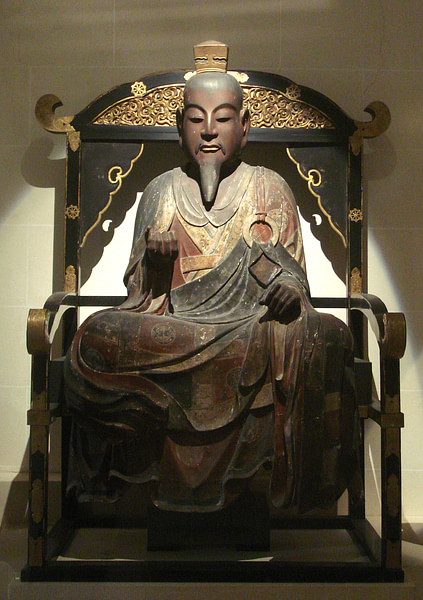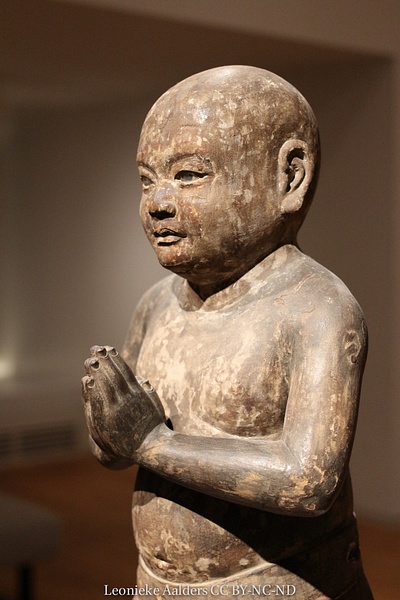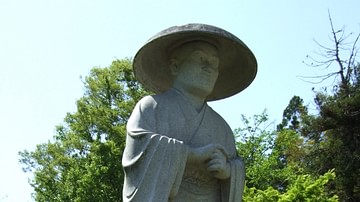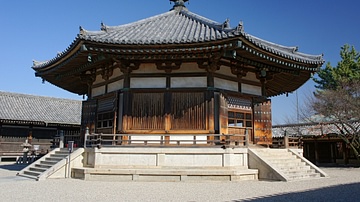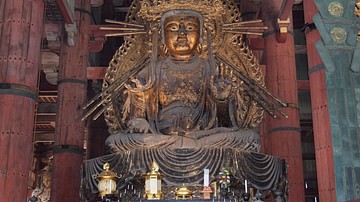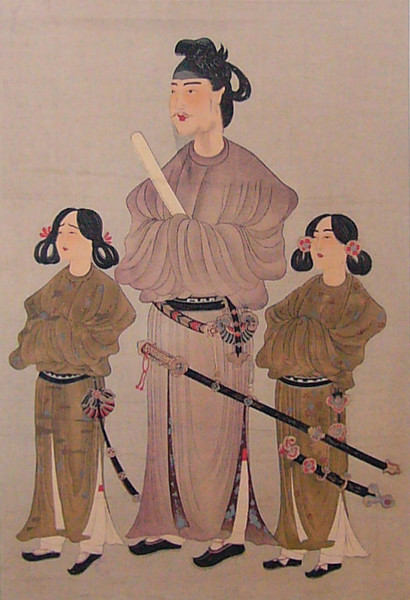
Prince Shotoku (574-622 CE) ruled as regent of Japan from 594 to 622 CE and is one of the most celebrated figures in all of Japanese history. The prince was a great supporter of Chinese culture and Buddhism, spreading both during his reign by encouraging closer ties with China, introducing principles of Chinese government, creating a constitution, and building many temples across Japan which included such famous sites as Shitennoji and Horyuji.
Shotoku's Accession
The prince, also known as Umayado no Miko and posthumously as Shotoku Taisha (meaning 'Prince of Supreme Virtue'), was born in 574 CE, the second son of Emperor Yomei (r. 585-587 CE) and grandson of Emperor Kimmei (539-571 CE). The prince also had ties to the powerful Soga clan which dominated Japanese politics at that time. Indeed, it would be the Soga clan leader Soga no Umako who plotted the assassination of Emperor Sushun (r. 587-592 CE), defeated the Nakatomi and Mononobe clans alliance, and put his own niece Suiko, the widow of Emperor Bidatsu (r. 572-585 CE), on the throne. Umako then selected Shotoku to rule as regent on behalf of his aunt. Quite why Umako selected the young Crown Prince to rule in 594 CE is not known, but we can surmise that he recognised his talents and, with his support of Buddhism and Chinese ways, thought he might prove a very useful ally for Soga interests. As it turned out, Umako remained in the political shadows and Shotoku became the shining light of a new Japan, a man who, ruling until his death in 622 CE, would become a legend in his own lifetime and a saint after it.
Shotoku's Government
Shotoku is credited with all manner of minor miracles and possessing such fanciful abilities as speaking from birth, giving audiences to ten men simultaneously, or even giving such moving lectures that lotus flowers rained down from Heaven, but more concrete achievements are his government reforms. In 604 CE Shotoku introduced the Chinese 'cap rank' system for state officials with 12 levels, each indicated by the colour of the official's hat. The prince also removed the right to impose taxes by anyone other than the emperor, rooted out corruption, and diminished the system of officials gaining office simply through inheritance. He introduced a Chinese-style calendar and, encouraging greater ties with China - seen as the great civilised nation of the region - sent official embassies to the Sui court from c. 607 CE and then throughout the 7th century CE.
The Seventeen Article Constitution
Shotoku is famously credited with drawing up a new constitution (or, perhaps more accurately, an ethical code) in 604 CE, called the Seventeen Article Constitution or Seventeen Injunctions (Jushichijo-kenpo). It may be that the constitution was not actually written by Shotoku but inspired by him and composed as a tribute following his death. The points made attempt to justify the centralisation of government and emphasised both Buddhist and Confucian principles, especially the importance of harmony (wa).
The constitution was unashamedly a promotion of the status quo and the power and authority of the emperor, which Shotoku believed, just like the laws of nature, should not and could not be challenged:
When you receive the Imperial commands, fail not to obey them scrupulously. The lord is Heaven, the vassal is Earth. Heaven overspreads, and Earth bears up. When this is so, the four seasons follow their due course, and the powers of Nature obtain their efficacy. If the Earth attempted to overspread, Heaven would simply fall in ruin. Therefore when the lord speaks, the vassal listens; when the superior acts, the inferior complies. Consequently when you receive the Imperial commands, fail not to carry them out scrupulously. Let there be a want of care in this matter and ruin is the natural consequence (Article III, Henshall, 499).
Ministers might have a natural, even a divine legitimisation of their authority, but they were, according to Shotoku, also bound by certain moral and ethical considerations:
The Ministers and functionaries should make decorous behaviour their leading principle (Article IV, ibid).
Ceasing from gluttony and abandoning covetous desires, deal impartially with the suits which are submitted to you (Article V, ibid).
Let the Ministers and functionaries attend the Court early in the morning and retire late (Article VIII, Henshall, 500).
Not a great deal of the content of the seventeen points were realised in practice during Shotoku's own lifetime, but it certainly had a lasting influence on later Japanese politics, for example, regarding article VIII quoted below and its emphasis on the importance of collective decision-making:
Decisions on important matters should not be made by one person alone. They should be discussed with many. But small matters are of less consequence. It is unnecessary to consult a number of people. It is only in the case of the discussion of weighty affairs, when there is a suspicion that they may miscarry, that one should arrange matters in concert with others, so as to arrive at the right conclusion. (Article XVII, Henshall, 502)
Supporting Buddhism
Buddhism was introduced to Japan sometime in the 6th century CE, traditionally in 552 CE. It was officially adopted by Emperor Yomei and further encouraged by Prince Shotoku, who emphasised the reverence of Buddhism in Article II of his constitution:
Sincerely reverence the three treasures. The three treasures, Buddha, the Law and the Priesthood, are the final refuge of the four generated beings, and are the supreme objects of faith in all countries. What man in what age can fail to reverence this law? Few men are utterly bad. They may be taught to follow it. But if they do not betake them to the three treasures, how shall their crookedness be made straight? (Henshall, 499)
True to his own declaration Shotoku built many temples and monasteries, formed a body of artists to create Buddhist images, and he was himself a student of its teachings, writing commentaries on three sutras. Buddhism was generally welcomed by Japan's elite (excepting initial resistance from the pro-Shinto Mononobe and Nakatomi clans) as it helped raise Japan's cultural status as a developed nation in the eyes of their powerful neighbours Korea and China, and helped legitimise the emperor as the centre of the Japanese political and religious spheres, increasing, too, his prestige.
During the reign of Shotoku 46 Buddhist monasteries and temples were built, the most important of which were the Shitennoji (built in 593 CE to commemorate the Soga's acquisition of power), Hokoji (596 CE), and Horyuji. The latter was completed in 607 CE but burnt down c. 670 CE, after which it was rebuilt; it is the only surviving monastery from the Asuka Period in its original state. The complex, consisting of 48 listed buildings including a 5-storey pagoda, has the oldest wooden buildings in Japan and several posthumous portraits of the prince.
Death & Legacy
The 720 CE Nihon Shoki ('Chronicle of Japan' and also known as the Nihongi) tells of the public's distress following the death of Prince Shotoku:
The princes and the grandees, and, indeed, the entire populace of the realm grieved so greatly the streets were filled with the sounds of their lamentation; the old wept as over the death of a dear child, and the food in their mouths lost its savor, the young as if they had lost a beloved parent. The farmer cultivating his fields let fall his plow, and the woman pounding her rice laid down her pestle. They all said: - "The sun and moon have lost their brightness; Heaven and Earth must surely soon crumble - from this time forth, in whom shall we place our trust?" (Keene, 70)
Empress Suiko would rule in her own right from 622 CE, and Shotoku's son would continue his father's work in spreading Buddhism, notably founding the temple of Hokki-ji in Nara. Shotoku's lasting contribution to the evolution of government in Japan and progressing towards a centralised state as opposed to the previous system of competing clans subject to the military might of the emperor is summarised, thus, by the historian W. G. Beasley:
…what he did was significant in two respects. He set out aspirations that eventually were to be orthodox in Japanese court politics; and by sending students to China, he made it possible for his successors to proceed on the basis of a much more thorough understanding of Chinese government. (22)
A cult quickly developed for Shotoku's contribution to spreading the popularity of Buddhism in Japan, and for his reputation as a guardian of good government, he was regarded by many as a saint-like figure, even an avatar of the Buddha, especially during the Kamakura Period (1185-1333 CE) when countless portraits of him as a child and adult in paintings and sculpture were created. Prince Shotoku continues today to be revered as one of the founding fathers of the Japanese civilization and one of its greatest and wisest rulers.
This content was made possible with generous support from the Great Britain Sasakawa Foundation.
